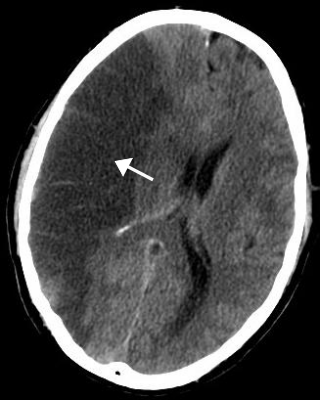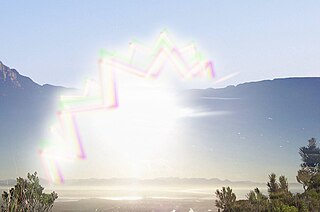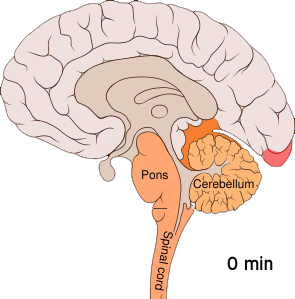Related Research Articles

Migraine is a genetically influenced complex neurological disorder characterized by episodes of moderate-to-severe headache, most often unilateral and generally associated with nausea and light and sound sensitivity. Other characterizing symptoms may include vomiting, cognitive dysfunction, allodynia, and dizziness. Exacerbation of headache symptoms during physical activity is another distinguishing feature. Up to one-third of migraine sufferers experience aura, a premonitory period of sensory disturbance widely accepted to be caused by cortical spreading depression at the onset of a migraine attack. Although primarily considered to be a headache disorder, migraine is highly heterogenous in its clinical presentation and is better thought of as a spectrum disease rather than a distinct clinical entity. Disease burden can range from episodic discrete attacks to chronic disease.
A transient ischemic attack (TIA), commonly known as a mini-stroke, is a minor stroke whose noticeable symptoms usually end in less than an hour. A TIA causes the same symptoms associated with a stroke, such as weakness or numbness on one side of the body, sudden dimming or loss of vision, difficulty speaking or understanding language, slurred speech, or confusion.

Headache, also known as cephalalgia, is the symptom of pain in the face, head, or neck. It can occur as a migraine, tension-type headache, or cluster headache. There is an increased risk of depression in those with severe headaches.

Micropsia is a condition affecting human visual perception in which objects are perceived to be smaller than they actually are. Micropsia can be caused by optical factors, by distortion of images in the eye, by changes in the brain, and from psychological factors. Dissociative phenomena are linked with micropsia, which may be the result of brain-lateralization disturbance.

Cerebrovascular disease includes a variety of medical conditions that affect the blood vessels of the brain and the cerebral circulation. Arteries supplying oxygen and nutrients to the brain are often damaged or deformed in these disorders. The most common presentation of cerebrovascular disease is an ischemic stroke or mini-stroke and sometimes a hemorrhagic stroke. Hypertension is the most important contributing risk factor for stroke and cerebrovascular diseases as it can change the structure of blood vessels and result in atherosclerosis. Atherosclerosis narrows blood vessels in the brain, resulting in decreased cerebral perfusion. Other risk factors that contribute to stroke include smoking and diabetes. Narrowed cerebral arteries can lead to ischemic stroke, but continually elevated blood pressure can also cause tearing of vessels, leading to a hemorrhagic stroke.

Stroke is a medical condition in which poor blood flow to the brain causes cell death. There are two main types of stroke:

Amaurosis fugax is a painless temporary loss of vision in one or both eyes.

Visual snow syndrome (VSS) is an uncommon neurological condition in which the primary symptom is that affected individuals see persistent flickering white, black, transparent, or colored dots across the whole visual field.

An aura is a perceptual disturbance experienced by some with epilepsy or migraine. An epileptic aura is actually a minor seizure.

Cerebral infarction, also known as an ischemic stroke, is the pathologic process that results in an area of necrotic tissue in the brain. In mid to high income countries, a stroke is the main reason for disability among people and the 2nd cause of death. It is caused by disrupted blood supply (ischemia) and restricted oxygen supply (hypoxia). This is most commonly due to a thrombotic occlusion, or an embolic occlusion of major vessels which leads to a cerebral infarct. In response to ischemia, the brain degenerates by the process of liquefactive necrosis.

Photopsia is the presence of perceived flashes of light in the field of vision.

Almotriptan is a triptan medication discovered and developed by Almirall for the treatment of heavy migraine headache.

Carotid artery dissection is a separation of the layers of the artery wall in the carotid arteries supplying oxygen-bearing blood to the head. It is the most common cause of stroke in younger adults. The term 'cervical artery dissection' should also be considered in the context of this article.

Cortical spreading depression (CSD) or spreading depolarization (SD) is a wave of electrophysiological hyperactivity followed by a wave of inhibition. Spreading depolarization describes a phenomenon characterized by the appearance of depolarization waves of the neurons and neuroglia that propagates across the cortex at a velocity of 1.5–9.5 mm/min.

Cerebral venous sinus thrombosis (CVST), cerebral venous and sinus thrombosis or cerebral venous thrombosis (CVT), is the presence of a blood clot in the dural venous sinuses, the cerebral veins, or both. Symptoms may include severe headache, visual symptoms, any of the symptoms of stroke such as weakness of the face and limbs on one side of the body, and seizures, which occur in around 40% of patients.
Persistent aura without infarction (PAWOI) is a rare and seemingly benign condition, first described in case reports in 1982 as "prolonged/persistent migraine aura status", and in 2000 as "migraine aura status", that is not yet fully understood. PAWOI is said to possibly be a factor involved in a variety of neurological symptoms, including visual snow, loss of vision, increased afterimages, tinnitus, and others. The pathogenesis of PAWOI is unknown. It is not clear which medical examinations are useful in diagnosing PAWOI. At present, PAWOI is usually diagnosed solely based on the patient's current and past symptoms. It is possible that an "overactive brain" or a chemical imbalance underlies the disorder. Various medications have been tried as treatment, notably acetazolamide, valproate, lamotrigine, topiramate, and furosemide.

Retinal migraine is a retinal disease often accompanied by migraine headache and typically affects only one eye. It is caused by ischaemia or vascular spasm in or behind the affected eye.

Illusory palinopsia is a subtype of palinopsia, a visual disturbance defined as the persistence or recurrence of a visual image after the stimulus has been removed. Palinopsia is a broad term describing a heterogeneous group of symptoms, which is divided into hallucinatory palinopsia and illusory palinopsia. Illusory palinopsia is likely due to sustained awareness of a stimulus and is similar to a visual illusion: the distorted perception of a real external stimulus.

Recurrent painful ophthalmoplegic neuropathy (RPON), previously known as ophthalmoplegic migraine (OM), is a rare neurological disorder that is characterized by repeated headache attacks and reversible ipsilateral paresis of one or more ocular cranial nerves (CN). Oculomotor nerve (CNIII) is by far the most common cranial nerve involves in RPON, while abducens nerve (CNVI) and trochlear nerve (CNIV) involvements are also reported. Globally, RPON was estimated to have an annual incidence rate of 0.7 per million as of 1990, no further epidemiological studies have been conducted. It occurs more often in children and females.
Spinal cord stroke is a rare type of stroke with compromised blood flow to any region of spinal cord owing to occlusion or bleeding, leading to irreversible neuronal death. It can be classified into two types, ischaemia and haemorrhage, in which the former accounts for 86% of all cases, a pattern similar to cerebral stroke. The disease is either arisen spontaneously from aortic illnesses or postoperatively. It deprives patients of motor function or sensory function, and sometimes both. Infarction usually occurs in regions perfused by anterior spinal artery, which spans the anterior two-thirds of spinal cord. Preventions of the disease include decreasing the risk factors and maintaining enough spinal cord perfusion pressure during and after the operation. The process of diagnosing the ischemic and hemorrhagic spinal cord stroke includes applying different MRI protocols and CT scan. Treatments for spinal cord stroke are mainly determined by the symptoms and the causes of the disease. For example, antiplatelet and corticosteroids might be used to reduce the risk of blood clots in ischaemic spinal stroke patients, while rapid surgical decompression is applied to minimize neurological injuries in haemorrhagic spinal stroke patients instead. Patients may spend years for rehabilitation after the spinal cord stroke.
References
- 1 2 Wolf, M. E.; Szabo, K.; Griebe, M.; Förster, A.; Gass, A.; Hennerici, M. G.; Kern, R. (2011-05-31). "Clinical and MRI characteristics of acute migrainous infarction". Neurology. 76 (22): 1911–1917. doi:10.1212/WNL.0b013e31821d74d5. ISSN 0028-3878. PMID 21624990. S2CID 12877187.
- 1 2 Laurell, K.; Artto, V.; Bendtsen, L.; Hagen, K.; Kallela, M.; Meyer, E. Laudon; Putaala, J.; Tronvik, E.; Zwart, J.-A.; Linde, M. (2011). "Migrainous infarction: a Nordic multicenter study". European Journal of Neurology. 18 (10): 1220–1226. doi:10.1111/j.1468-1331.2011.03364.x. ISSN 1468-1331. PMID 21414105. S2CID 39572704.
- ↑ Laurell, K.; Lundström, E. (2012-06-01). "Migrainous Infarction: Aspects on Risk Factors and Therapy". Current Pain and Headache Reports. 16 (3): 255–260. doi:10.1007/s11916-012-0262-2. ISSN 1534-3081. PMID 22527790. S2CID 39992424.
- ↑ Rasmussen, B. K.; Olesen, J. (1992-08-01). "Migraine With Aura and Migraine Without Aura: An Epidemiological Study". Cephalalgia. 12 (4): 221–228. doi:10.1046/j.1468-2982.1992.1204221.x. PMID 1525797. S2CID 24120063.
- 1 2 3 Nieuwkamp, D. J.; van der Schaaf, I. C.; Biessels, G. J. (2010-08-01). "Migraine aura presenting as dysphasia with global cognitive dysfunction and abnormalities on perfusion CT". Cephalalgia. 30 (8): 1007–1009. doi:10.1111/j.1468-2982.2009.02007.x (inactive 31 January 2024). PMID 20656713.
{{cite journal}}: CS1 maint: DOI inactive as of January 2024 (link) - 1 2 3 4 5 Viana, M.; Linde, M.; Sances, G.; Ghiotto, N.; Guaschino, E.; Allena, M.; Terrazzino, S.; Nappi, G.; Goadsby, P. J.; Tassorelli, C. (2016-04-01). "Migraine aura symptoms: Duration, succession and temporal relationship to headache". Cephalalgia. 36 (5): 413–421. doi:10.1177/0333102415593089. ISSN 0333-1024. PMID 26156076. S2CID 10701108.
- 1 2 3 Russell, M. B.; Olesen, J. (1996). "A nosographic analysis of the migraine aura in a general population". Brain. 119 (2): 355–361. doi: 10.1093/brain/119.2.355 . ISSN 0006-8950. PMID 8800932.
- ↑ Santos, E.; Sánchez-Porras, R.; Dohmen, C.; Hertle, D.; Unterberg, A. W.; Sakowitz, O. W. (2012-03-09). "Spreading depolarizations in a case of migraine-related stroke". Cephalalgia. 32 (5): 433–436. doi:10.1177/0333102412441414. PMID 22407661. S2CID 25190650.
- ↑ Schott, G. D. (2007-06-01). "Exploring the visual hallucinations of migraine aura: the tacit contribution of illustration". Brain. 130 (6): 1690–1703. doi: 10.1093/brain/awl348 . ISSN 0006-8950. PMID 17264093.
- ↑ Schankin, C. J.; Maniyar, F. H.; Sprenger, T.; Chou, D. E.; Eller, M.; Goadsby, P. J. (2014-06-01). "The Relation Between Migraine, Typical Migraine Aura and "Visual Snow"". Headache: The Journal of Head and Face Pain. 54 (6): 957–966. doi: 10.1111/head.12378 . ISSN 1526-4610. PMID 24816400. S2CID 4164884.
- ↑ Greenlund, K. J.; Neff, L. J.; Zheng, Z. J.; Keenan, N. L.; Giles, W. H.; Ayala, C. A.; Croft, J. B.; Mensah, G. A. (2003-11-01). "Low public recognition of major stroke symptoms". American Journal of Preventive Medicine. 25 (4): 315–319. doi:10.1016/S0749-3797(03)00206-X. ISSN 0749-3797. PMID 14580633.
- ↑ Iadecola, C.; Alexander, M. (2001-02-01). "Cerebral ischemia and inflammation". Current Opinion in Neurology. 14 (1): 89–94. doi:10.1097/00019052-200102000-00014. ISSN 1350-7540. PMID 11176223.
- ↑ Pancioli, A. M.; Broderick, J.; Kothari, R.; Brott, T.; Tuchfarber, A.; Miller, R.; Khoury, J.; Jauch, E. (1998-04-22). "Public Perception of Stroke Warning Signs and Knowledge of Potential Risk Factors". JAMA. 279 (16): 1288–1292. doi: 10.1001/jama.279.16.1288 . ISSN 0098-7484. PMID 9565010.
- 1 2 Montaner, J.; Perea-Gainza, M.; Delgado, P.; Ribó, M.; Chacón, P.; Rosell, A.; Quintana, M.; Palacios, M. E.; Molina, C. A.; Alvarez-Sabín, J. (2008-01-16). "Etiologic Diagnosis of Ischemic Stroke Subtypes With Plasma Biomarkers". Stroke. 39 (8): 2280–2287. doi: 10.1161/STROKEAHA.107.505354 . ISSN 0039-2499. PMID 18535284. S2CID 1690024.
- ↑ Wessels, T.; Röttger, C.; Jauss, M.; Kaps, M.; Traupe, H.; Stolz, E. (2005-04-01). "Identification of Embolic Stroke Patterns by Diffusion-Weighted MRI in Clinically Defined Lacunar Stroke Syndromes". Stroke. 36 (4): 757–761. doi: 10.1161/01.STR.0000158908.48022.d7 . PMID 15746460. S2CID 15123728.
- ↑ Jauss, M.; Wessels, T.; Trittmacher, S.; Allendörfer, J.; Kaps, M. (2006-08-01). "Embolic Lesion Pattern in Stroke Patients With Patent Foramen Ovale Compared With Patients Lacking an Embolic Source". Stroke. 37 (8): 2159–2161. doi: 10.1161/01.STR.0000231645.22128.ab . PMID 16825590. S2CID 6290227.
- ↑ Ameri, A.; Bousser, M. G. (1992-02-01). "Cerebral Venous Thrombosis". Neurologic Clinics. 10 (1): 87–111. doi:10.1016/S0733-8619(18)30235-4. ISSN 0733-8619. PMID 1557011.
- ↑ Stam, J. (2005-04-28). "Thrombosis of the Cerebral Veins and Sinuses". New England Journal of Medicine. 352 (17): 1791–1798. doi:10.1056/NEJMra042354. ISSN 0028-4793. PMID 15858188. S2CID 42126852.
- ↑ Rothrock, J.; North, J.; Madden, K.; Lyden, P.; Fleck, P.; Dittrich, H. (1993-12-01). "Migraine and migrainous stroke: Risk factors and prognosis". Neurology. 43 (12): 2473–6. doi:10.1212/WNL.43.12.2473. ISSN 0028-3878. PMID 8255442. S2CID 19346752.
- 1 2 Headache Classification Committee of the International Headache Society (IHS) (2018-01-25). "The International Classification of Headache Disorders, 3rd edition". Cephalalgia. 38 (1): 1–211. doi: 10.1177/0333102417738202 . ISSN 0333-1024. PMID 29368949. S2CID 45901670.
- ↑ Zeller, J. A.; Frahm, K.; Baron, R.; Stingele, R.; Deuschl, G. (2004-07-01). "Platelet–leukocyte interaction and platelet activation in migraine: a link to ischemic stroke?". Journal of Neurology, Neurosurgery & Psychiatry. 75 (7): 984–987. doi:10.1136/jnnp.2003.019638. ISSN 0022-3050. PMC 1739108 . PMID 15201354.
- 1 2 3 D'Andrea, G.; Toldo, M.; Cananzi, A.; Ferro-Milone, F. (1984-03-01). "Study of platelet activation in migraine: control by low doses of aspirin". Stroke. 15 (2): 271–275. doi: 10.1161/01.STR.15.2.271 . PMID 6230778. S2CID 18475833.
- ↑ Hedman, C.; Winther, K.; Knudsen, J. B. (1988). "Platelet function in classic migraine during attack-free periods". Acta Neurologica Scandinavica. 78 (4): 271–277. doi:10.1111/j.1600-0404.1988.tb03656.x. ISSN 1600-0404. PMID 2851913. S2CID 22505883.
- ↑ Olesen, J.; Friberg, L.; Olsen, T. S.; Andersen, A. R.; Lassen, N. A.; Hansen, P. E.; Karle, A. (1993-02-01). "Ischaemia-induced (symptomatic) migraine attacks may be more frequent than migraine-induced ischaemic insults". Brain. 116 (1): 187–202. doi:10.1093/brain/116.1.187. ISSN 0006-8950. PMID 8453456.
- ↑ Kreling, G. A. D.; de Almeida, N. R.; dos Santos, P. J. (2017-06-30). "Migrainous infarction: a rare and often overlooked diagnosis". Autopsy & Case Reports. 7 (2): 61–68. doi:10.4322/acr.2017.018. ISSN 2236-1960. PMC 5507571 . PMID 28740841.
- ↑ Lee, H.; Whitman, G. T.; Lim, J. G.; Yi, S. D.; Cho, Y. W.; Ying, S.; Baloh, R. W. (2003-01-01). "Hearing Symptoms in Migrainous Infarction". Archives of Neurology. 60 (1): 113–116. doi: 10.1001/archneur.60.1.113 . ISSN 0003-9942. PMID 12533097.
- ↑ Thie, A.; Spitzer, K.; Lachenmayer, L.; Kunze, K. (1988). "Prolonged Vasospasm in Migraine Detected by Noninvasive Transcranial Doppler Ultrasound". Headache: The Journal of Head and Face Pain. 28 (3): 183–186. doi:10.1111/j.1526-4610.1988.hed2803183.x. ISSN 1526-4610. PMID 3290157. S2CID 40373513.
- ↑ Marshall, N.; Maclaurin, W. A.; Koulouris, G. (2007). "MRA Captures Vasospasm in Fatal Migrainous Infarction". Headache: The Journal of Head and Face Pain. 47 (2): 280–283. doi:10.1111/j.1526-4610.2007.00695.x. ISSN 1526-4610. PMID 17300370. S2CID 30746415.
- ↑ Wehinger, C.; Stöllberger, C.; Länger, T.; Schneider, B.; Finsterer, J. (2001-10-01). "Evaluation of Risk Factors for Stroke/Embolism and of Complications Due to Anticoagulant Therapy in Atrial Fibrillation". Stroke. 32 (10): 2246–2252. doi: 10.1161/hs1001.097090 . PMID 11588308. S2CID 14703460.
- 1 2 Hommel, M. (1996-07-18). "Thrombolytic Therapy with Streptokinase in Acute Ischemic Stroke". New England Journal of Medicine. 335 (3): 145–150. doi: 10.1056/NEJM199607183350301 . ISSN 0028-4793. PMID 8657211.
- ↑ Hacke, W.; Kaste, M.; Fieschi, C.; von Kummer, R.; Davalos, A.; Meier, D.; Larrue, V.; Bluhmki, E.; Davis, S.; Donnan, G.; Schneider, D. (1998-10-17). "Randomised double-blind placebo-controlled trial of thrombolytic therapy with intravenous alteplase in acute ischaemic stroke (ECASS II)". The Lancet. 352 (9136): 1245–1251. doi:10.1016/S0140-6736(98)08020-9. ISSN 0140-6736. PMID 9788453. S2CID 53549605.
- 1 2 Hacke, W.; Kaste, M.; Bluhmki, E.; Brozman, M.; Dávalos, A.; Guidetti, D.; Larrue, V.; Lees, K. R.; Medeghri, Z.; Machnig, T.; Schneider, D. (2008-09-25). "Thrombolysis with Alteplase 3 to 4.5 Hours after Acute Ischemic Stroke". New England Journal of Medicine. 359 (13): 1317–1329. doi: 10.1056/NEJMoa0804656 . ISSN 0028-4793. PMID 18815396. S2CID 12016921.